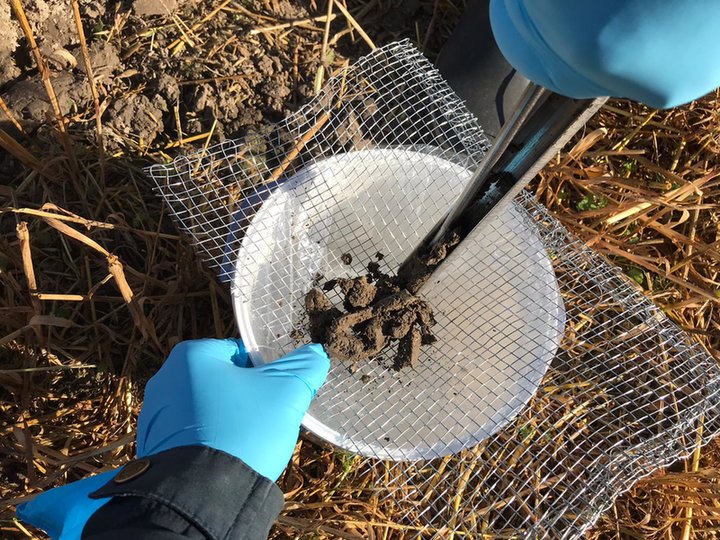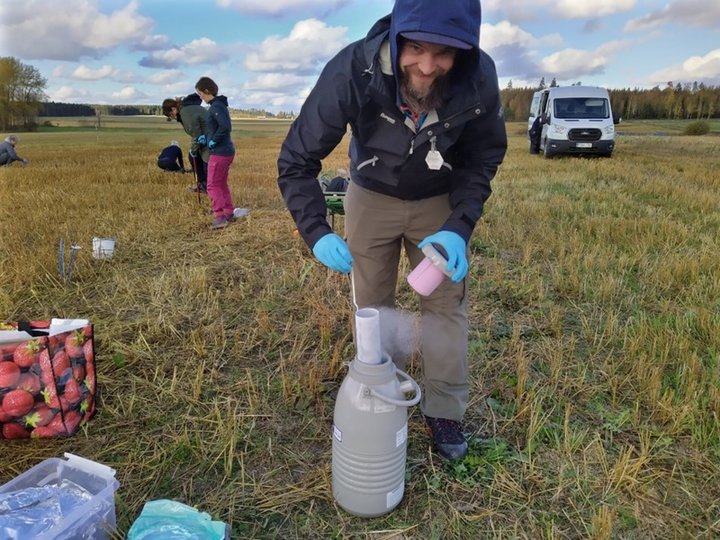KEYWORDS
Soil microbiomet
Sustainable food systems
Loss of carbon
Biodiversity
Sustainability
Irritable bowel syndrome
Abstract
Gut motility is central to bowel function, and dysmotility leads to slow transit and constipation, which is associated with primary gastrointestinal and extraintestinal disorders. Gut transit time, stool frequency, consistency, and bloating are the main clinical outcomes of interest for dysmotility in constipation and are affected by age, gender, lifestyle, and medication use. Although dietary and lifestyle modifications and several lines of pharmacological treatments have been used to treat constipation, new long-term therapeutic solutions are needed to improve treatment satisfaction. To this end, the efficacy of probiotics in the management of constipation has varied. Future randomized controlled trials should thus be based on well-defined probiotic preparations with at least 2 trials, designed, and reported according to unified global standards.
The microbiome is everywhere
While the microbiome is commonly associated with our guts, it is important to recognise that microorganisms are everywhere, and they play a critical role in our everyday life. An interesting case is the soil microbiome, the community of microorganisms (including viruses, bacteria, archae, and fungi) that live in the soil and are essential for its health, fertility, as well as nutrient cycling and plant growth. However, the soil microbiome doesn’t only play a crucial role in ensuring a sustainable food supply for our growing population, but also, somewhat unexpectedly, impacts our health.
Studies conducted in a joint project of the University of Helsinki and the Natural Resources Institute of Finland have recently explored the relationship between the microbial quality of our environment, specifically soil, and the incidence of inflammatory disorders in children, such as allergies, asthma, and type 1 diabetes (1). The biodiversity hypothesis (2) postulates that such disorders may result from weak interactions with environmental microbes, causing an imbalance in immune regulation. To explore this hypothesis, researchers conducted a 2-year intervention comparing standard urban day-care centers with playgrounds amended with a biodiverse forest floor vegetation and soil. The study found that intervention strategies can enrich commensal (beneficial) microbiota and suppress potentially pathogenic bacteria on the skin, ultimately reducing the incidence of immune-mediated diseases in children.
These findings underscore the importance of protecting and restoring the health of our soil to ensure the long-term health of both humans and the environment. In CIRCLES, an EU-funded project, we explore food production systems from two important angles. First, we investigate microbiome interactions and circulation within six food chains: spinach, tomatoes, poultry, swine, farmed and wild salmon and seabream. Secondly, we study the potential of manipulating the soil microbiomes. (3)
Soil microbiomes are important: They mitigate carbon loss & help combat climate change
Over 95% of our food, including fruits, vegetables, grains, meat, and dairy, is directly or indirectly reliant on soil (FAOSTATs 2022). However, intensive farming practices and poor soil management have led to one-third of the world’s soil becoming degraded, resulting in a loss of fertility and an inability to support plant growth. These practices can cause essential nutrient leaching and physical damage to soil structure, disturbing the complex ecosystem of microorganisms that live in soil.
Soil microbiomes play a crucial role in maintaining ecosystem balance. They have multiple functions, including purification of forming groundwater, decomposition, formation of clumps of soil called aggregates, cycling of nitrogen, pathogen control, and uptake of nutrients and water for plants in natural ecosystems. Soil microbiomes also aid in carbon sequestration, making them important in reducing carbon loss. Recent estimates suggest that up to half of persistent carbon in soil comes from dead microbes (4). Bacteria and fungi help to transform photosynthesized carbon into more stable forms in the soil by breaking down organic matter and creating new substances that hold the soil together. Fungi are particularly important for soil health because they help to keep the soil carbon stable and form aggregates that hold water and prevent soil erosion and nutrient loss. The greater the variety of microbes in the soil, the better the soil’s ability to hold water and nutrients.
Harnessing the microbiome for sustainable agriculture
The work of CIRCLES comprises studies on the microbiomes of both food chains and soil. A pronged methodological approach is performed to elucidate the impact of the crop and other food chain microbiomes on sustainable agriculture.
The "observation phase" involves researchers working with crop growers on "lab-in-the-field" sites to perform a "census" of the microbiome associated with both more and less productive plants. This approach is known as comparative metagenomics and uses state-of-the-art DNA sequencing technologies. Then follows an "Intervention phase", where researchers use bioinformatics tools to mine the comparative metagenomics results and identify what is missing or imbalanced in the microbiome of less productive plants. Researchers then attempt to restore a healthy microbiome with a targeted application on the farm of natural microbes and/or products. They assess the intervention by measuring crop performance, as well as the impacts on the environment and people participating in the crop production process.

Experiments with the soil microbiome in forests show promising results
At the Natural Resources Institute of Finland, the focus has been on studying the impact of new substrates, such as forest industry side streams, as food for soil microbes to enhance their diversity and quantity. This approach, instead of applying living microbes into soil, was chosen because competition by the native microbes inhabiting the soil often weakens the survival of any applied microbial inoculum. Our particular aim was to enhance fungal communities because agricultural management practices (e.g. ploughing) disturb fungi more than bacteria, creating an imbalance in crop fields compared to undisturbed soil ecosystems.
We conducted two studies. In the first, we applied different organic sludges from the pulp and paper industry to agricultural fields and studied their impact on cereal yields, soil erodibility and carbon content, and the composition of soil fungi and bacteria (5). The results showed that applying these substrates led to changes in the relative proportions of numerous microbial groups and an increase in the pools of microbial-bound carbon and nitrogen in the soil. We also observed an increased proportion of several fungal taxa, which indicates improved quality of agricultural soil. However, we have yet to determine to what extent microbiological interactions with soil minerals explain improved soil stability.
In our second study, we conducted a microcosm experiment using tree bark and its cascade-processed residuals to explore impacts on microbial communities in arable soil (6). The study aimed to simulate the seasonal temperature changes of the boreal region and counteract the decline in the carbon content of agricultural soils that has been reported globally. The study provides valuable insights into how different amendments can affect the soil microbiome and, consistent with the results of the first study, possesses potential to contribute to the overall sustainability of agricultural soils.
To further enhance the sustainability of using microorganisms in agriculture, our research is using Life Cycle Assessment (LCA) methodology to assess the environmental impact, Life Cycle Costing (LCC) methodology to analyse the cost impact, and techno-economical analysis (TEA) to conduct a cost-benefit analysis.

Next steps
Our studies have shown the potential of using forest industry side-streams to improve the soil microbiome, particularly the fungal communities, and thereby promote sustainable agriculture. But while our findings provide valuable insights regarding the possibility of changing the makeup of indigenous microorganisms in agricultural soils for plant health, further studies are needed to fully understand the mechanistic features and the impact of organic soil amendments on soil carbon quality and stability.
Nevertheless, our laboratory and field studies have demonstrated the potential of modifying the microbiota of agricultural fields and we look forward to continuing our research in this area. Together with the microbiome modulation activities of food production, our framework in the CIRCLES project will translate into strategies that preserve natural resources and ensure the production of safe and nutritious crops.

Juha-Matti Pitkänen (front), Sannakajsa Velmala and Tuija Hytönen (back) sampling and cooling soil microbial DNA/RNA with liquid nitrogen in Jokioinen, Southern Finland, Luke experimental fields.
References and notes
- Roslund M I, Puhakka R, Nurminen N, Oikarinen S, Siter N, Gröönroos M, Cinek O, Kramná L, Jumpponen A, Laitinen OH, Rajaniemi J, Hyöty H, Sinkkonen A 2021.Long-term biodiversity intervention shapes health-associated commensal microbiota among urban day-care children. Environment International 157 106811. doi.org/10.1016/j.envint.2021.106811
- Hanski I, von Hertzen L, Fyhrquist N, Koskinen K, Torppa K, Laatikainen T, Karisola P , Auvinen P, Paulin L, Mäkelä MJ, Vartiainen E, Kosunen TU, Alenius H, Haahtela T 2012. Environmental biodiversity, human microbiota, and allergy are interrelated. PNAS 109: 8334-8339 https://doi.org/10.1073/pnas.1205624109
- CIRCLES project website: https://circlesproject.eu/
- Liang C, Amelung W, Lehmann J, Kästner M 2019. Quantitative assessment of microbial necromass contribution to soil organic matter. Global Change Biology 25: 3578-3590.
- Rasa K, Pennanen T, Peltoniemi K, Velmala S, Fritze H, Kaseva J, Joona J, Uusitalo R 2021. Pulp and paper mill sludges decrease soil erodibility. Journal of Environmental Quality 50: 172-184. DOI: 10.1002/jeq2.20170
- Peltoniemi K, Velmala S, Fritze H, Jyske T, Rasi S, Pennanen T 2023 Impacts of coniferous bark-derived organic soil amendments on microbial communities in arable soil–a microcosm study. FEMS Microbiology Ecology 99.3 (2023): fiad012. DOI: 10.1093/femsec/fiad012


